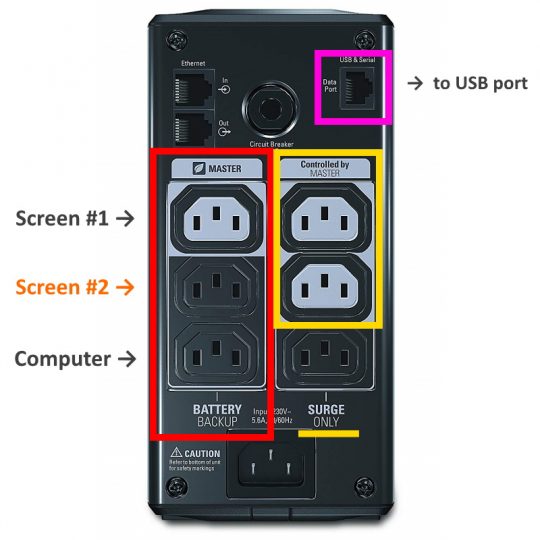 So, you buy a UPS (uninterruptible power supply) for your puter.
So, you buy a UPS (uninterruptible power supply) for your puter.
You hook it up.
Then, a power outage or brownout hits…
POOF! Your puter reboots.
“Hang on”, you think, “Wasn’t my battery backup supposed to prevent this?”
Yes, it was… But there are a few things you need to check to make things work nicely…
Size your UPS properly
For most people, any battery backup that is rated at 500 VA or higher should be just fine.
Especially nowadays with lower-LCD computer monitors, that should be plenty even if you have 2 screens.
So, if you have a fancy gaming rig and a cheap 300VA UPS, you might want to upgrade.
Connect everything properly
Now, here it gets tricky.
First of all, most UPSes have 2 rows of sockets on the back: Battery Backup and Surge Only.
You want your puter + screen(s) connected to the Battery Backup sockets – NOT the surge suppression-only ones.
Only use the surge suppressor sockets for other less important peripherals and gizmos that don’t matter as much as your puter.
The point is not to power absolute everything; it’s to protect your puter and screens, which are the most expensive part of your computing station!
Next, be aware of the whole Master-Slave controlled sockets on many UPSes.
For example, maybe you have an APC BackUps RS 550:

Take a peek on the back of this UPS, and you’ll see the following:

You want to plug your puter + screen(s) into the sockets in the red box, which are Battery Backup sockets.
You also want to pay attention because on some UPSes, the socket labeled Master can also control 1 or 2 other sockets in the Battery Backup group. If this is the case, be sure to plug your puter into NEITHER a Master or Slave socket – if possible!
The reason for this is that if you go browse, say, the APC help forum, you’ll find a ton of people who found that the whole Master/Slave thing often doesn’t work properly.
In any case, with the above UPS, I’d connect the puter to the bottom outlet (see above), Screen #1 to the Master, and Screen #2 (if present) to the second socket.
Even if the UPS’s Master socket goes wonky, the worst that will happen is my screen may go to sleep when I’m on battery power, but my puter will be nice and protected! If it works properly, everything will be powered during an outage.
Finally, be sure to connect the supplied data cable to the pink port (see above), and then connect the other end of the cable to any USB port on your puter.
This data cable is what allows your puter to talk to the UPS and monitor battery power. Without it, the puter doesn’t know when AC power has been cut or when the battery is running low and it’s time to hibernate!
Don’t trust Windows 10
Now that you’ve wired everything up in the best way possible, it’s time to think about software.
Windows 10 is supposed to work nicely with every UPS out there.
I have found that this is simply not the case.
With many older UPSes, Win 10 works fine. But with newer UPSes (especially the more expensive “Pro” line of APC UPSes pictured above), Windows 10 seems to report that you have no battery life left even when the UPS display shows it’s at 100%. And then your puter shuts down or reboots during even the slightest brownout…
So, in the case of an APC UPS, go to their web site and download the PowerChute Personal software and then install it.
For other makes and models of battery backup, see the manufacturer’s web site or install the software from the included CD. This ensures that Windows 10 will work perfectly with the UPS, and you’ll stop having those pesky reboots when your battery level is at 100%.
A note for Asus customers
If you have an Asus motherboard that’s a few years old, go into the BIOS/UEFI and see if there is an Anti-Surge Support option.
This is a feature Asus used to put in its motherboards that would shut down the puter if there was a power fluctuation. The latest motherboards no longer have this feature, but older ones might.
You’ll want to turn this OFF if it’s there because apparently, even Asus itself now recommends you do so since it never quite worked very well…
The “feature” could cause your puter to power down even if your UPS is functioning correctly!
As usual, it’s complicated
Well, you probably thought that hooking up a battery backup to your puter would be a piece of cake.
Unfortunately, it very frequently causes more problems than it’s supposed to solve.
Hopefully, now you have a better idea of what to do to get the most out of your trusty UPS!
Finally, be sure to pay attention after your UPS is several years old. The internal battery wears out over time (3-5 years), and will eventually need to be replaced.
Usually, you’ll know the battery is kaput when you have a power outage, and the UPS only runs your puter for 1-2 minutes before shutting down. Or, the UPS will give a crazy beep or two and display an error message, a red light, or just turn off completely.
Fortunately, you can easily find replacements on Amazon.
That’s all, folks!




Recent Comments